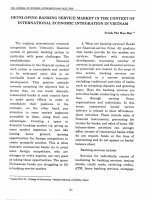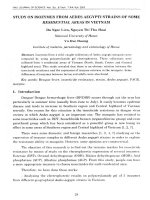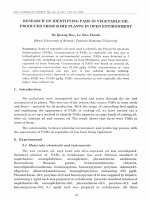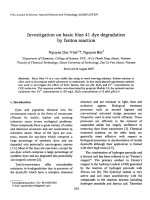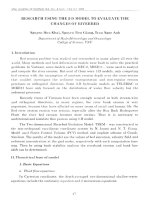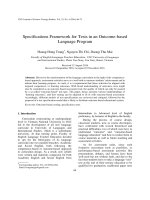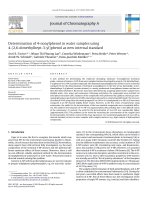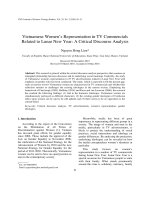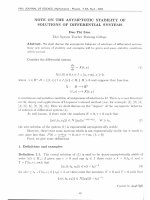DSpace at VNU: Research on identifying pahs in vegetable oil produced from some plants in open environment.
Bạn đang xem bản rút gọn của tài liệu. Xem và tải ngay bản đầy đủ của tài liệu tại đây (2.49 MB, 6 trang )
VNU JO U R N A L OF SCIENCE. Nat., Sci . & Tech., T XX. N01, 2004
RESEARCH ON IDENTIFYING PAHS IN VEGETABLE OIL
PRODUCED FROM SOME PLANTS IN OPEN ENVIRONMENT
Do Q u a n g H u y , Le N h u T h a n h
H anoi U niversity o f Science, V ietnam N a tio n a l U niversity
S u m m a r y . Some of vegetable oils were used to identify the Polycyclic Aromatic
Hydrocarbons (PAHs). Contamination of PAHs in vegetable oils was due to
technological processes or environmental sources. PAHs were detected in 3
vegetable oils, including raw coconut oil from Philippine, soya bean and oliverapeseed oil from Vietnam. Concentration of PAHs was found in coconut oil,
the maximum concentration was 22.048 |ig/kg. PAHs’ concentration in soya
bean, olive-raspeseed oils was low, it was reduced during refining.
Benzo(a)pyrene wasn’t detected in all samples, the maximum concentration of
other PAHs was 10.640 ng/kg. PAHs concentration in raw vegetable oils were
higher than refined oils.
1. I n t r o d u c t io n
The p ollu ta n ts were tr a n s p o r t e d into land and w a te r th ro u g h the air, and
acc u m ulate d in plants. This was one of the re aso n t h a t cause s PAHs in some seeds
and fruits - m aterial for oil production. With the target of controlling food quality
a nd explaining the a p p e a ra n c e of PAHs in cooking oil, we have carried out a
res ea rch to set up a method to identify PAHs q u a n ti t y in some kinds of cooking oil,
olive oil, soybean oil a nd coconut oil. The r e s u l t shows t h a t t h e r e were PAHs in
some of them..
The r ela tio n ship betw een p lan tin g e n v iro nm en t an.d producing process with
the a p p e a ra n c e of PAHs in vegetable oil has been being explained.
2. E x p e r im e n t a l
2.1. M a te r ia ls , c h e m ic a ls a n d i n s t r u m e n t s
The ra w coconut oil, soya bean and olive-rapeseed oil was investigated.
S t a n d a r d solution of PAHs in cyclohexane was used. Solution s t a n d a r d of
n a p h th a le n e ,
ace n ap h th y le ne ,
ace naph thene ,
phenanthrene,
an th ra ce n e,
flu oran then e,
fluorene,
pyrene,
benz o(a)anthracene,
chrysene,
benzo(bjka)fluoranthenes, benzo(e)pyrene, benzo(a)pyrene, perylene, indeno(123cd)pyrene, dib en z (ah)a nth ra ce n e, benzo(ghi)perylene con ta in in g 500 pg/àl.
P h e n a n t h r e n e - d l O , p e r y l e n e - d l 2 a nd benzo(e)pyrene-dl2 wa s supplied by Supelco,
c on ta in ing 1 ng/àl each was p r e p a r e d in cyclohexane. I n t e r n a l s t a n d a r d solution of
n a p h t h a l e n e - d 8, a c e n a p h t h y le n e - d i o , p h e n a n t h r e n e - d i o , p e r y l e n e - d l 2 and
b e n zo(e )pyrene-dl2, 0,1 àg/ml each was p r e p a r e d in cyclohexane. All these
63
Do Q u a n g H uy, Le N h u T h a n h
64
solutoins were stored a t 5°c.
The solvents for ex tra ct a nd clean up were
cyclohexane, d im ethylform am ide, ethylac etate , n-hexane.
Silica gel, 70-230 mes h for column c h ro m a to g r a p h y was removed i m p u r itie s
possibly p resen t by h ea tin g overnight at 5 50°c. Before use, standardize by adding
10 % (v/v) of distilled water, after agitation allow to s t a n d for 2 h.
Bio-Bead S-X3, 200-400 mesh was also used in cleaning proceduce.
The H e w l l e t - P a r k a r d 5973 m as s sp ectrom eter interfaced with Agilent 6890
GC was used. HP-5, 30 m X 0,25mm fused silica column wa s use d with h e liu m as
the carrier gas a t 1.2ml/min, p r e s su re 6.31psi. Splitless injection 250°c was
employed. The oven t e m p e r a t u r e was p ro g ram m ed 70°c, 1 min, 5°c/min, 280°c, and
keeping a t 280°c unt il all com ponents were eluted.
The m ass sp e ctro m eter p a r a m e t e r s used were as follows: electron impa ct
energy 70 eV, source t e m p e r a t u r e 250°c, t r a n s f e r line 280°c.
In the SIM mode, th e ions monitored were m/e 136, 68 ( n a p h t h a l e n e - d 8), m/e
128, 129 (nap h th a le n e), m/e 162, 164 (acenaphthyle ne-dlO), m/e 151, 152
(acenaphthylene), m/e 153, 154 (ac enaphthene), m/e 164, 166 (fluorene), m/e
186,188 (p h e n a n th r e n e - d lO ), m/e 176,178 (p h e n a n th r e n e , a n th ra ce n e), m/e 200, 202
(fluoranthene, pyrene), m/e 226,228 (benzo(a)anthracene, chrysene), m/e 250, 252
(benzo(bjka)fluoranthenes, benzo(e)pyrene, benzo(a)pyrene, perylene), m/e 260, 264
(peryl ene-dl 2,
benzo(e)py re ne-dl2),
m/e 276, 277 (indeno(123-cd)pyrene,
benzo(ghi)perylene), m/e 278, 279 (dibenz(ah)anthracene), Figure 1.
2.2. C le a n u p p r o c e d u r e
25 gram of vegetable oil in 250 ml s e p a r a t i n g funnel, add 2 ml i n te r n a l
s t a n d a r d solution was solved in 100ml cyclohaxane. The m ix ture was extr a cted by
dimethylform am ide : H 20 (9:2, v/v) t h ree tim es with portions of 50 ml, 25 ml, 25 ml.
The extract of sa m ple was diluted with 100 ml of 1 % N a 2S 0 4 solution. After adding
50 ml cyclohexane, the m itu re was e xtracted again with 25 ml of
dimethvlfor m am ide : w a t e r (9:2; v/v). The e x tr a c t was w a sh e d with distilled w a t e r
and t h e n dried with a n h y d r o u s sodium sulfate. The e x tr a c t was c o n ce n tra te d on a
rotary evap o rator to 1 ml a t 40°c.
C h r o m a to g r a p h y column (500 m m X 0.6 m m i.d.) was packed a 5 gram of:
silica gel (content 10 % of water). Load p r e p a r e d e x tr a c t on th e column. 90 ml of
cyclohexane wa s used as a solvent to clean up a nd elute PAHs from column. Discard
10 ml of first fraction (FI), a n d concentrate 80 ml of secơnd fration to 2 ml (F2).
Bio-Bead S-X3 column ( 300 m m X 20 mm) was used to clean up a g a i n th e F2
solution. The m ix tu re of cyclohexane : e th y lac eta te (1:2, v/v) was u sed as a solvent
to clean up and elute PAHs from column. Flow r a t e of th e m ix tu re of cyclohexane :
eth ylacetate (1:2, v/v) wa s 5 ml/min. Adding 3 ml of e th y lac eta te to F2 solution, load
this solution on the column. Collect th e 50 - 120ml fractiort a nd c o n cen tr ate on a
Research on id e n tify in g p a h s in vegetable oil fro d u c e d f r o m .
65
rotary e v a p o r a to r to 5 ml. T r a n f e r a residue into a sa m ple vial, dr ynes s u n d e r
nitrogen st r e a m , a n d dissolve in 100 àl toluene. This solution was used to identify
PAHs on GC-MS.
3. R e s u lt s a n d d i s c u s s i o n
A sa m p le of r a w coconut oil wa s produced in Philippine was analyzed to
identify PAHs. The sa m ple h a s not been refined, still h a s distinctive smell and
colour of th e i n p u t m aterial.
CM
O
si
CO CD
i c
ễc «o
2c
II
II
4.0e4-
U - CL
Q_ <
8
Soo
CN
0CD
II
Is
c
§
N - (O
CO 0 0
o Ọ
CNCỘ
0)
).c0)
J0
C
cCO c03 or—
N I
ml
oo^
S'S" 0)
o 'o ' I
N N u
0 0) >s
CD CŨ 5 -
CNJ
05
'f- c
©
c55 £sz®
N.
3.0e4-
00
CM
o>
h. ro
TO<
2.0e4-
1.0e4.
i
W
(D
yr-^r
cn
■À
1----- 1
20
OCDrncirt
NJCNCN
iắiUL
s
P in
OTT
coco
ọ N-
H®
liL J u L _ J
T------- 1------- r
30
I
11_ỉ L-—'
T-----r~
40
Fi gure 1. Mass chromatograms by SIM mode of PAHs.
According to th e table 1, the PAHs concentration in the sa m ple was r a t h e r
high, the conce n tra tion ran ge was from not found to 22.048 ng/kg. Among group of
PAHs, g r e a t a tt e n t i o n h a s been paid to group of s u b s ta n c e s with high cancer
p o ten tiality as benzo(a)pyrene, b e n zo(a )anthracene, d ibenz(a)anth ra cene. The
co ncentration ra n g e was
from not found to 9.478 |ig/kg. Com pared to the
benzo(a)pyrene - p e r m i tt e d s t a n d a r d in It a l ia n food, be nzo(a)pyrene in raw coconut
oil was 3 tim e s higher. Moreover, th e a p p e a ra n c e of high PA Hs concentration
m ea n s the high risk of being cancer.
00
Do Q u a n g Huyy Le N h u T h a n h
T a b l e 1. Concentration of PAHs in vegetable oils (ụg/kg)
Compounds
Raw
coconut oil
Soya bean
oil 1
Soya bean
oil 2
Oliverapeseed
oil 1
Oliverapeseed
oil 2
Naphthalene
22.048
7.68
6.68
10.610
6.451
Acenaphthylene
4.041
-
-
0.122
0.401
-
-
-
0.101
-
Acenaphthene
Fluoranthene
9.478
1.25
0.89
0.027
-
Phena nthrene
2.460
0.29
-
-
-
Anthracene
2.460
0.35
-
-
0.012
Fluorene
2.372
1.58
2.76
-
-
Pyrene
0.439
-
-
-
Benzo(a)anthracene
0.615
3.34
-
-
-
-
-
-
-
0.123
Chrysene
-
Benzo(b)fluoranthene
0.176
-
-
-
-
Benzo(k)fluoranthene
0.088
-
-
-
-
5.67
0.058
-
Benzo(a)pyrene
-
1.11
Dibenz(a,h)anthracéne'
-
-
-
-
-
Benzo(ghi)perylene
-
4.89
2.03
0.079
0.237
Note : (-) not detected
The PAHs c on te n t in Philippine raw coconut oil was compared h i g h e r t h a n
t h a t of G e rm a n . However, benzo(a)pyrene in G e r m a n y ra w coconut oil wa s very
high, from 0.5 to 2.3 |!g/kg. The an alyzing r e s u l t was completely r e l e v a n t to the
conclusion t h a t raw coconut oil conta in s h ig h es t PAHs content.
Two sa m ple s of refined soybean oil have been analyzed to find o ut PAHs. The
PAHs concentration ra n g e was from not found to 7.68 |!g/kg for each. N a p h t h a l e n e
was
identified
highest.
Among
15
PAH
s u b s ta n c e s
we
analyzed
benzo(a)anthracene, benzo(a)pyrene, d ib enz(a)anth racene, which were most
poisonous, were not found.
Compared to th e benzo(a)pyrene - p e r m i tt e d s t a n d a r d in I t a l i a n food, the
benzo(a)pyrene co ncen tr atio n in th e sa m p le s was u n d e r th e s t a n d a r d . However,
through first e x perim e nts, th ese two soybean oil sa m p le s co ntain some PAHs
causing cancer as indeno (123-cd)pyrene with th e concentration of 1.11 jag/kg in
sample 1, a n d 5.57 |ig/kg in sa m ple 2.
The existence of PA Hs in soybean oil sa m p le s was due to th e a c c u m u l a t i o n in
grains and the form ation in the processing. Soybean p l a n t was a h e rb a c e o u s p lant
with shor t height, large a nd rough leaves easily absorb ing PAHs d e p o site d by
polluted air. Besides, in processing, soybean with high protein is possibly converted
R esearch on id e n tify in g p a h s in vegetable oil fro d u c e d from .
67
into PAHs. However, most PAHs were elim in ate d d u r i n g the raw oil refining
process.
We also carry out an alyzing PAHs in two samples of olive oil. This was the
m a te r ia l with high oil a nd low protein content. Though m a te r ia l was imported from
t e m p e r a t e climate countries, the producing process was highly economically
effective. The PAHs c onte nt in the samples was low, r a n g in g from not found to
10.61 ng/kg. The sa m ple s contain some c an c er-p o ten tial substanc es, as
benzo(b)fluoranthene 0.123 ng/kg in sample 2 a nd indeno(123-cd)pyrene 0.058
|ig/kg in sample 1. Benzo(a)pyrene was not found in both samples.
O u r sa m p le -an a ly z in g resu lts were showed t h a t th e PA Hs concentration in
olive oil were lowest. The re aso n can be t h a t colza and olive - th e m a te r ia l supply grow a nd develop in a n open e n v iro nm en t with low PAHs concentration a n d t h a t
the com ponents in th ese g rains were less likely to be converted into PAHs.
4. C o n c lu s io n
T h ro ug h research on identifying PAHs in vegetable oil, we have d r a w n out the
following conclusions: PAHs content in Philippine raw coconut oil was high, from
not found to 22.048 jig/kg. Benzo(a)pyrene co ncentration in th e sample is 0.088
fig/kg, th e total PA Hs up to 45.415 |ig/kg. PAHs c onte nt in the refined soybean
sample was low, from not found to 7.68 |ig/kg. Benzo(a)pyrene wa s not found in the
two samples. Soybean oil does not contain PAHs as th ey are e lim in a te d during
refining process. PAHs c onte nt in olive and colza oil sa m p le s were quite low, the
concentration ran ge from not found to 10.61 |ig/kg. C om pared to th e sta n d a r d , the
benzo(a)pyrene content in olive and cozal oil w as perm itted. PAHs con ten t in raw
oil was much more h ig her t h a n in refined oil. Colour-was hing method elim inates
most poisonous su b s ta n c es t h a t cause cancers. However, PA Hs have been found
th ro u g h four refined oil samples. Produc ers should have m ethods to reject them
completely from processed oil.
R e fe r e n c e
1.
Hopia A., Pyysalo H. & Wichstromk, Margarines, butte r and vegetable oils as
sources of PAHs, I.Am . oil chem.soc., 63, 1996, pp 889-893.
2. Menichini E., Bocca A., Merli F. & Monfedni F., PAHS in olive oils on the Italian
market, Food A ddit. Contam., 8 , 1991, pp 363-369.
3. Sagredos AN., Sinha - Roy D. & Thomas A., Determination, sources & composition
of PAHs in oils and fats, Fat Sci. T e c h n o 90, 1998, pp 76-81 (in German).
Do Q u a n g Huy9 Le N h u T h a n h
68
TAP CHỈ KHOA HOC DHQGHN, KHTN & CN. T XX, sỏ' 1, 2004
N G H I Ê N CỨU XÁC Đ ỊN H CÁC HIDROCACBON T H Ơ M ĐA VÒNG
TRONG DẦU ẢN SẢN XUẤT t ừ q u ả , h ạ t c ủ a m ộ t s ố LOÀI T H ự C VẬT
GIEO TRỔNG TRONG MÔI TRƯ ỜN G MỞ
Đỗ Quang Huy, Lê Như Thanh
Trường Đại học Khoa học T ự nhiên, Đ ại học Quốc gia H à nội
Về b ả n c h ất tự nhiên, các loại d ầ u thực v ậ t đều không chứa các hidrocacbon
thơm đa vòng (PAHs), c h úng bị nh iễm b ẩ n các c h ấ t này trong các quá t r ì n h xử lý kỹ
t h u ậ t hay t ừ môi trường. Chú n g tôi đã tiến h à n h xác định PAHs trong ba loại dầu
thực v ậ t : d ầ u dừa của P h ilippin (thô), dầu n à n h và d ầ u o l iu - h ạ t cải (đã qua tinh
luyện) của Việt nam. Đã p h á t hiện ra h à m lượng cao của PAHs trong d ầ u dừa với
giá trị cực đại là 22,048 ụg/kg. Trong khi đó, h à m lượng của PAHs trong d ầ u n à n h
và dầu oliu- h ạ t cải là t h ấ p và h à m lượng này giảm khi được tin h chế. Benzo(a)pyrene khôn g tìm t h ấ y trong cả ba loại dầu. Tóm lại, PAHs được tìm t h ấ y trong cả
ba loại dầu thực vật và h à m lượng của nó trong dầu thô cao hơn trong d â ù đã được
tinh chế.

